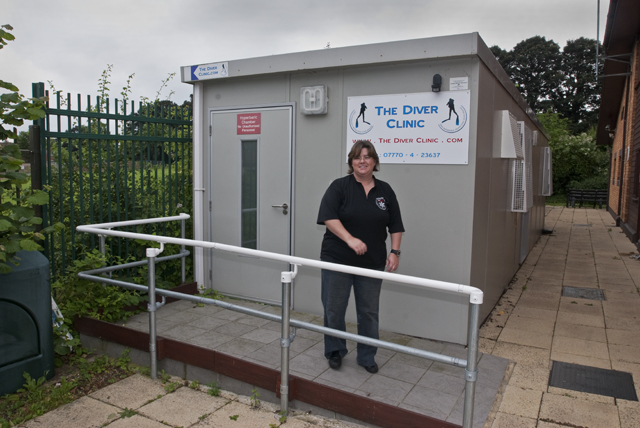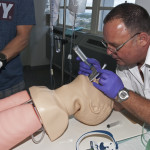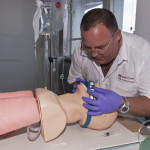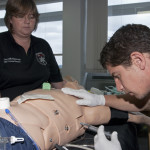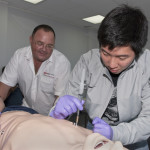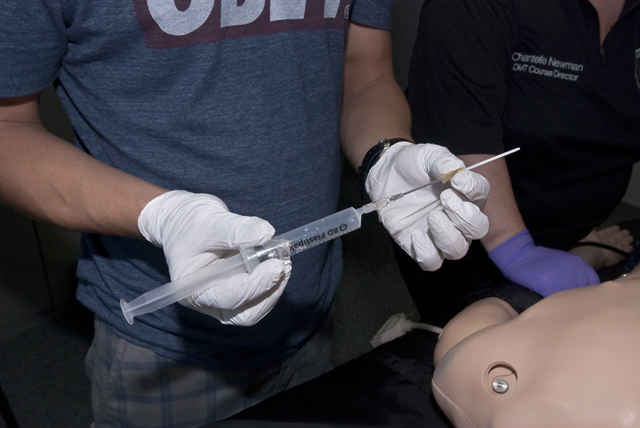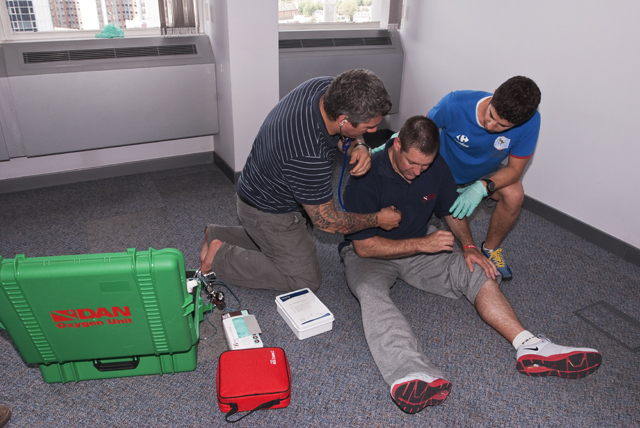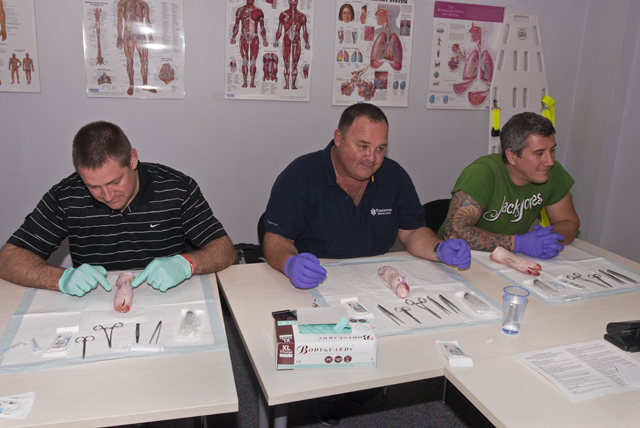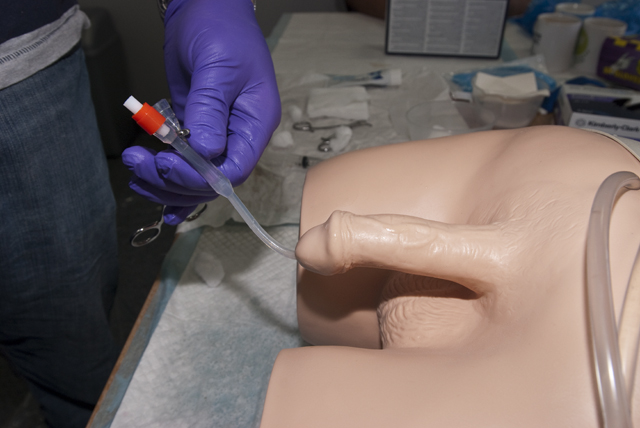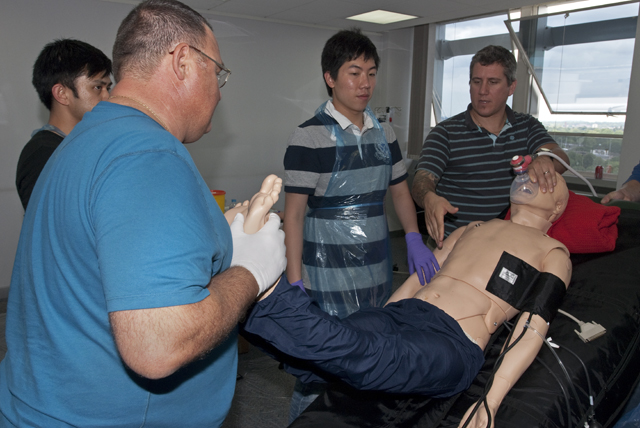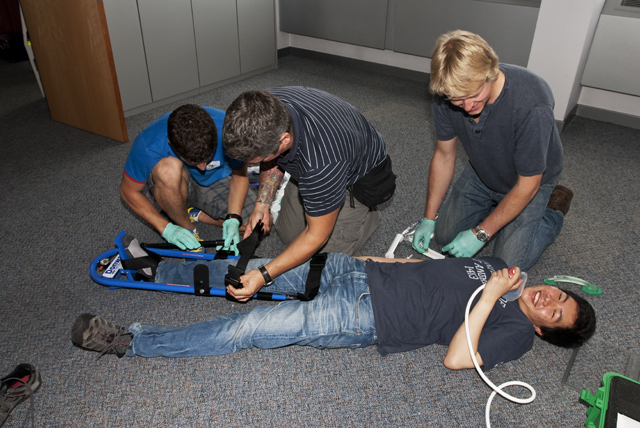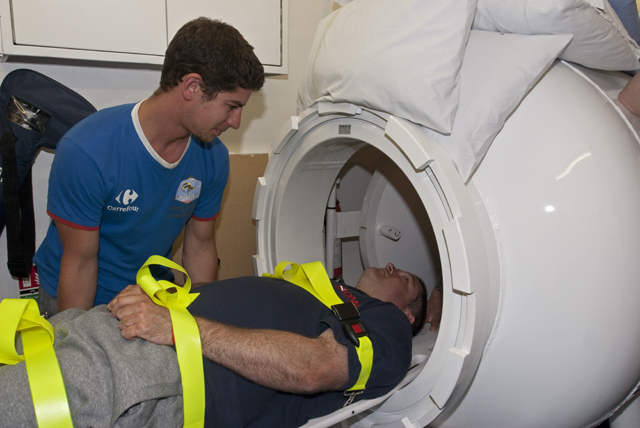Dive Training Blogs
Further into First Aid: DAN’s Diver Medic Technician Course
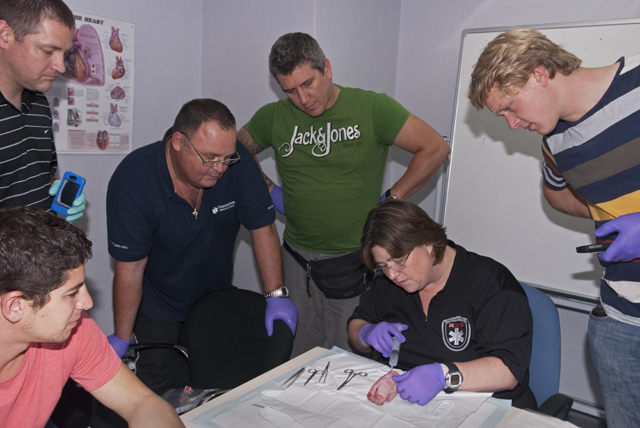
Let’s face the facts, diving accidents do happen. Thankfully not too often, but as an active scuba diver the law of probability states that sooner or later I will encounter some kind of first aid emergency. With this in mind I would hate to be unprepared or unable to help someone in their moment of need. So when I saw the advert on DAN Europe’s website promoting the diver medic technician (DMT) course run by Code Blue Education, I thought this was the perfect time for a refresher on the latest medical techniques and procedures.
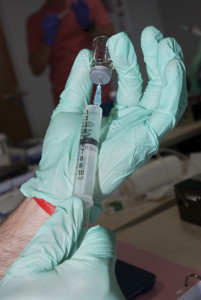 As well as covering the basic ABC’s the 2-week (80 hour) course entered into the realms of suturing, IV cannulation, catheterisation and dealing with a real life pneumothorax. I was really looking forward to the suturing session but the thought of catheterising a patient didn’t really fill me with inspiration. In fact I went weak at the knees just thinking about the procedure.
As well as covering the basic ABC’s the 2-week (80 hour) course entered into the realms of suturing, IV cannulation, catheterisation and dealing with a real life pneumothorax. I was really looking forward to the suturing session but the thought of catheterising a patient didn’t really fill me with inspiration. In fact I went weak at the knees just thinking about the procedure.
My last dabble with any form of medical training was a St John’s Ambulance first aid at work course several years ago. I was worried that my level of knowledge would be way below the required standard, but Chantelle Taylor-Newman, Director of Code Blue Education, reassured me that my background would be fine. I didn’t need to bring along any materials as everything from tea, coffee, soft drinks and chocolate muffins to all the course notes and even my own personal stethoscope would be included. I was already starting to get delusions (but then again, Doctor Philpott did have a certain ring to it!).
Chantelle said the DMT course is aimed at commercial and recreational divers. It’s actually an offshore requirement to have one DMT in each commercial diving team. Chantelle, who is also a certified PADI Divemaster, said “The DMT course is designed for commercial divers, but these days there seems to be more accidents in recreational diving, so I feel that it should be taught to all recreational divers as well.”
Code Blue Education is based in Brentford, London. They offer the full range of DAN courses up to Instructor level. The DAN/IMCA (International Marine Contractors Association) accredited DMT course is a new addition to their medical training portfolio. Chantelle said “We are looking at running the course every 2-3 months.” The content is currently around 40% theory and 60% practical work. There is a mid-week multiple choice exam followed by a final written and practical exam watched over by a practising medical professional.
Chantelle gave me some website links for pre-course reading, so when I turned up on Monday morning, I was raring to go. Even having to give a personal introduction in front of the group couldn’t dampen my enthusiasm. There was a good mix of people from different countries and job backgrounds. Andrea had just completed a commercial job looking for dead bodies on the Concordia cruise liner in Italy, and Oliver had been welding pipe work inside a sewage tank somewhere in Oz. Jason was studying economics in Scotland and Chris was working for the forestry commission in the home counties. The white collar workers were represented by Morne from DAN South Africa and Clive who owned 2 decompression chambers in Cyprus.
The first two days mainly consisted of theory focusing on physiology and basic first aid principles. Chantelle emphasised that hygiene was extremely important by saying “you can find faecal matter just about everywhere” (that’s such a nice thought!). Guest speaker Cary Marcelo, a care procedures and resuscitation Instructor working at Harley Street, went through the signs, symptoms and treatment for patients suffering from a variety of injuries. We had quite a few acronyms to remember. ABCDE and SAMPLE were the most widely used. Cary’s catchphrase was “Always treat what kills first.” During the practical sessions everybody had to wear gloves and use the oral nasal masks. I never realised how easy it was to use an AED (automated external defibrillator) – the unit basically talked me through the whole procedure. We also went through how to check blood pressure using a sphygmomanometer and a stethoscope.
Police diver Steve McKenna turned up mid-week to go through wounds, bleeding and fractures. Steve has worked with the marine unit for the past 14 years and gets called out on jobs anywhere in London. He had some very interesting (and gory) stories about past investigations. I can still visualise the picture showing a severed penis! Steve’s catchphrase was “We are going to lose people.” Steve explained that even with first aid treatment some people will die; in fact, the actual quoted figure is a 5% survival rate if an accident happens out on the street.
The day wouldn’t be complete without a few new acronyms to memorise. This time SAFE and RICE seemed to be the favourites. By far the best product Steve showed us was Celox. The haemostatic granules were developed for military use to stop severe bleeding. They are now being used by civilian paramedics. DAN even sells the packs on their website. The practical session using spinal boards, scoop stretchers and cervical collars gave everybody a chance to stretch their legs. I soon realised that trying to manoeuvre a stretcher and patient up and over objects and around tight corners is not an easy task.
To finish off the week we had a theory day on diving physics and diving related injuries. I already knew most of the information from my PADI Divemaster days so this was really just a refresher. Some of the pictures of skin and facial barotraumas (suit and mask squeeze) looked horrendous, but Chantelle reassured us that the injuries had healed up without any permanent injury.
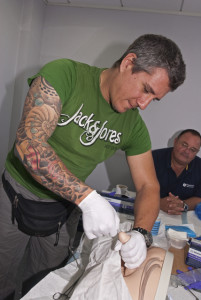
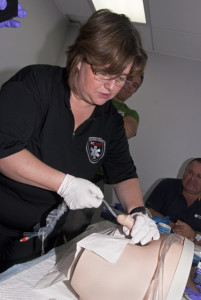 The second week involved more complex procedures starting with IV cannulation. I am not a fan of needles so this was quite an interesting session. We all got to practise on the plastic/rubber training arms that were filled with fake blood. Even I managed to get the procedure right after a few tries. Catheterisation had everybody grimacing apart from Chantelle who seemed to be smiling as she performed the delicate demonstration. Watching someone put a 30cm long catheter inside a penis brought tears to my eyes (it wasn’t a real penis I might add. We used a training manikin). This is one procedure I would not want to do in real life. Morne, from DAN South Africa, pointed out to me that the correct medical term for the male genitalia is a winky!
The second week involved more complex procedures starting with IV cannulation. I am not a fan of needles so this was quite an interesting session. We all got to practise on the plastic/rubber training arms that were filled with fake blood. Even I managed to get the procedure right after a few tries. Catheterisation had everybody grimacing apart from Chantelle who seemed to be smiling as she performed the delicate demonstration. Watching someone put a 30cm long catheter inside a penis brought tears to my eyes (it wasn’t a real penis I might add. We used a training manikin). This is one procedure I would not want to do in real life. Morne, from DAN South Africa, pointed out to me that the correct medical term for the male genitalia is a winky!
Doctor Mark Downs was our next guest speaker. Mark is an HSE Medical Examiner. He is one of only eighty doctors in the country that can conduct commercial diving medicals. Mark is an active PADI Divemaster and has been diving for 10 years. We listened to Mark’s presentations on diving related accidents and how to check out a possible bends case. Mark said “the 5 minute neuro exam provides a reliable system to judge the urgency of a diving emergency. It also demonstrates to the diver involved that there is a problem and convinces them to commence oxygen first aid treatment.” Mark’s catchphrase was “Oxygen is the answer to all diving related injuries.” He stated that in two thirds of all DCI cases there will be some kind of neuro damage, which is quite a sobering thought. We looked at the DDRC, DAN and Mark Powell’s neuro assessment sheets and tried them out on each other for good measure.
Before taking the dreaded exams we spent an interesting day with Spencer Phillips at the Diver Clinic’s recompression chamber based in Reading. Spencer has more than 20 years experience in decompression therapy. We sat through an in-depth presentation on the ‘bends’ going through the general causes and treatments. Spencer said he had recently seen an increase in trimix rebreather related incidents quoting one particular case where a woman wasn’t carrying any bale out gas for a dive in the 50-100m range. When the unit failed she came to the surface missing a considerable amount of deco time. Spencer quoted some interesting statistics. He said that in the UK there is a one fatality per 200,000 dives and one decompression related incident for every 5,000 dives. Rapid ascents seemed to be the main problem. Between 70-80% of the cases he treats are Type 1 bends. 98% of symptoms appear within 24 hours, 50% are within the first hour. Spencer said “time to treatment is crucial for getting a good result.”
On the final day everybody passed the written exams and scenarios with flying colours. Code Blue Education’s second ever DMT course had been a resounding success. The problem I find with any course is trying to retain all the relevant information. After 2 full weeks of theory and practical sessions my brain was about to explode. I had thoroughly enjoyed the course, especially the practical scenarios. Having specialists speakers come in and give presentations definitely made the course more interesting and helped increase everyone’s attention span, although on a few occasions listening to different perspectives did lead to confusion as to what was the correct procedure to use.
Going through accident scenarios in a controlled classroom environment is never the same as facing a real life emergency situation. I kept wondering, how would I react? What I do know is Code Blue Education’s DMT course has certainly raised my first aid skill levels, so if there ever was a situation I had a far better chance of helping someone out.
Participant Fact File
Name: Morne Christou
Resides: Jo’burg, South Africa
Job title: DAN South Africa Office Manager
Years in diving: 12
Qualifications: PADI Instructor
Reasons for participating: To further my knowledge and see how the course is run from a DAN perspective so we can work together with Code Blue on future courses.
Observations: Great course, lots of information I didn’t know. Long days so need to stay focused.
Guest Speakers: From my experience it’s nice to have different speakers. It adds to the dynamics although sometimes there was conflicting information.
Best moments: Definitely the practical sessions, I can really relate to it.
Rating: 8/10
[hr style=”single”]
Name: Clive Martin
Resides: Larnaca, Cyprus
Job title: Decompression Chamber owner
Years in diving: 27
Qualifications: PADI Master Instructor, BSAC Advanced Instructor
Reasons for participating: Increase knowledge.
Observations: Overall I really enjoyed the course. It’s not just diver related, other injuries are included.
Guest Speakers: Not so monotonous with other speakers, it really broke up the days.
Best moments: The hand’s on stuff, scenarios, especially the IV, advanced airway and suturing.
Rating: 7/10
[hr style=”single”]
Name: Jason Teoh
Resides: Malaysia, Kuala Lumpa
Job title: Student studying economics at St Andrews in Scotland.
Years in diving: 5
Qualifications: PADI Instructor, Emergency Medical Technician.
Reasons for participating: I already have basic EMT knowledge but wanted more diving related knowledge.
Observations: Very informative. It covers lots of topics and encompasses lots of diving aspects. I originally trained on the American system so it was good to learn the European standard.
Guest Speakers: It was nice to get different perspectives.
Best moments: Definitely the suturing.
Rating: 8/10
[hr style=”single”]
Name: Chris Jenkins
Resides: UK, Devon
Job title: MD of a forestry company
Years in diving: 2
Qualifications: PADI Rescue Diver
Reasons for participating: Increase personal knowledge.
Observations: I haven’t wasted my time, it was a good course. On a medical level I learnt an adequate amount. I would recommend it to the right person.
Guest Speakers: Nice to break the 2 weeks with different speakers.
Best moments: the practical sessions, especially life support.
Rating: 8/10
[hr style=”single”]
Name: Andrea Cerilli
Resides: Monza, Italy
Job title: Commercial Diver
Years in diving: 4 years as a commercial diver, 8 saturation jobs including the Concordia.
Qualifications: PADI Instructor, air and saturation diver
Reasons for participating: There has to be a DMT on every sat diving team. It’s nice to learn more so maybe I can help someone.
Observations: Generally very good, I learnt a lot.
Guest Speakers: I liked the different lectures. It was nice to hear them talking about their own experiences.
Best moments: the practical
Rating: 7/10
[hr style=”single”]
Name: Oliver Bittar
Resides: Perth, Australia
Job title: Commercial Diver, NW shelf
Years in diving: 4 years as a commercial diver
Qualifications: SSI Master Diver, commercial air diver, degree in marine biology
Reasons for participating: Gain better employment opportunities, extra knowledge.
Observations: Brilliant, really like the course. Lots of information condensed into 2 weeks, particularly the 2nd half. Good course construction and particularly good revision for me.
Guest Speakers: Having specialists added a massive part to being a good course.
Best moments: The hands on practical, especially the IV cannulation.
Rating: 9/10
Blogs
Jeff Goodman Launches Underwater Moviemaker Course with NovoScuba

Transform Your Dive Experiences into Cinematic Masterpieces
NovoScuba has partnered with acclaimed underwater filmmaker Jeff Goodman to introduce the Underwater Moviemaker Course—a revolutionary program designed to equip divers with the skills to capture the breathtaking beauty of the underwater world.
Whether you’re an aspiring filmmaker, an avid diver, or a photography enthusiast, this course offers the tools and expertise needed to create stunning underwater videos. From vibrant coral reefs to curious marine life, you’ll learn how to film, edit, and produce captivating underwater stories, all with expert guidance from a seasoned professional.
Jeff Goodman: A Legacy in Underwater Filmmaking
Jeff Goodman brings over 40 years of experience in underwater film production for television to this course. Reflecting on his career, Jeff said:
“Although technology has dramatically changed, the basics of underwater filming remain constant. This course covers crucial skills for producing great videos. Whether you’re creating professional broadcast films or high-quality hobby videos, the fundamental principles are the same.
A camera operator must master their equipment to capture those magical underwater moments effortlessly. But beyond technical know-how, underwater filmmaking is about having fun and enhancing your diving experiences. So, take your time, learn at your own pace, and enjoy this creative journey.”
About NovoScuba
Founded in 2023, NovoScuba is reshaping dive education with a comprehensive, digitally native platform. Offering cutting-edge training programs for divers at all levels, NovoScuba sets a new benchmark in the diving industry by combining innovation with accessibility.
With ISO-certified courses, a student subscription model, and multilingual support, NovoScuba ensures that dive education is inclusive and engaging. More than just a training provider, NovoScuba fosters a global community of divers committed to exploration, collaboration, and sustainability.
Join the NovoScuba Underwater Moviemaker Course Today!
Dive into the world of underwater filmmaking and start creating cinematic stories that inspire. Learn more about the course and enroll today at www.novoscuba.com/novoscuba-underwater-moviemaker-course.
EXCLUSIVE: Jeff Goodman interviews Mark Spiers, CEO of New Scuba Diving Training Agency NovoScuba
NovoScuba’s Game-Changing Approach for Dive Store Owners: WE PAY YOU!
The diving world thrives on passion and adventure, but for many dive store owners, the financial and operational challenges can be as deep as the ocean.
NovoScuba, an emerging force in the diving world, is on a mission to transform this landscape for the better. With a revolutionary approach to dive store and training agency partnerships, NovoScuba is setting new standards for how dive stores can thrive while keeping their focus on delivering exceptional diving experiences.

A New Paradigm: NovoScuba’s Bold Mission
NovoScuba’s mission is straightforward yet profound: to disrupt the traditional dynamics between dive store owners and training agencies. Traditionally, dive stores have been subjected to substantial fees charged by training agencies, for membership, materials and certifications. These costs have often placed a heavy financial burden on store owners, cutting into their profits and limiting their ability to offer competitive prices to customers.
NovoScuba flips the script by offering a model where dive stores earn money, instead of paying high fees. Dive stores receive commissions for every student they register, and their certification costs are covered. This new model not only boosts profitability but also ensures clients get top-quality training at unbeatable prices.
Financial Upsides: Earn From Student Registration
NovoScuba’s approach is simple yet revolutionary. Dive stores partnering with NovoScuba can earn commissions for every student they enroll.
Here’s how it works: For every student enrolled through NovoScuba, dive stores receive a commission. Each student enrolled will receive their e-learning materials and certification credit included in their subscription. This arrangement is a significant departure from the traditional model, where dive stores often struggle to manage high overhead costs related to training fees and certification expenses.

NovoScuba’s approach ensures that dive stores can focus on what they do best—providing top-notch diving experiences—without being bogged down by excessive financial burdens, and the need to carry large stocks of materials.
Quality Training at a Great Price
NovoScuba stands out by offering high-quality, ISO certified, training that doesn’t break the bank, in fact our students will pay less than with most competing agencies. Clients benefit from top-notch education and safety standards at competitive prices. Dive store owners can confidently promote NovoScuba’s programs, knowing they’re offering fantastic training at affordable rates. This balance of quality and affordability helps dive stores build a strong reputation and attract more customers.
Your Brand is Your Business: NovoScuba’s Commitment to Showcasing Your Identity
At NovoScuba, we understand that your brand is your most valuable asset, and we’re committed to putting it front and centre. Unlike agencies that charge high fees to promote their own brand, we believe in investing in yours. With NovoScuba, you won’t be paying to advertise someone else’s logo alone, — our focus is on showcasing your unique identity. Certifications prominently feature your brand, as well as the training agency, reinforcing your store’s image and brand every step of the way. We’re here to support and elevate your brand, ensuring that your investment directly benefits your business.
Affordable Membership: An Investment in Your Success
NovoScuba’s membership model is designed with dive store owners in mind. Membership fees are kept low and include annual Pro member fees for your team. Payment can be made monthly or annually in your local currency, avoiding the hassle of exchange rate fluctuations. NovoScuba promises no exchange rate changes without a six-month notice, ensuring financial stability and simplifying budgeting. With a membership lasting 12 months from date of joining, you’ll enjoy a full year of NovoScuba’s benefits and support.

Streamlined Operations: Simplifying Your Workload
Handling administrative tasks can be a challenge, but NovoScuba makes it easier. We’ve streamlined certification procedures and reduced paperwork to help dive stores operate more efficiently. Certification processing is quick and straightforward, allowing more focus on teaching and customer service. Our system minimises bureaucracy by storing necessary forms in student profiles, reducing paperwork and administrative delays.
Crossover Made Easy
For dive stores looking to transition to NovoScuba’s model, the crossover process is designed to be smooth and hassle-free. NovoScuba provides support to ensure that the transition is as seamless as possible, helping dive store owners integrate into the new system with minimal disruption. Experienced dive Pros don’t need to undergo extensive retraining. Our crossover is designed to familiarise Pros with NovoScuba’s user-friendly platform, standards and course structures, and not to waste time and expense re-training in water.
With just a few simple steps, you’ll be ready to offer top-notch training through NovoScuba.
Comprehensive Business Support and Training Included in Your Membership
NovoScuba goes beyond financial benefits by offering experienced support and training. This value added service includes:
- Business Training: Optimise your operations with guidance on marketing, customer service, and best practices.
- Marketing and Promotion: Access resources to attract new customers and boost your store’s visibility. Enjoy cross promotions with NovoScuba to gain increased exposure.
- Ongoing Support: NovoScuba’s commitment to its partners extends beyond initial training and setup. The company offers ongoing support to address any issues or questions that arise. This continuous support ensures that dive store owners have a reliable resource to turn to whenever they need assistance.

Embracing Digital Natives: Instant Evolution and Continuous Improvement
NovoScuba’s digital-native approach is a game-changer. Leveraging cutting-edge technology, we ensure our services evolve and improve swiftly. Dive stores benefit from instant updates, the latest features, enhancements, and effective solutions, keeping them ahead of the curve. This continuous improvement helps dive stores stay competitive and deliver exceptional services. Whether it’s a new course update, additional marketing resources, or improved e-learning functions, NovoScuba’s digital infrastructure ensures that dive stores are always equipped with the most current and effective solutions. This continuous evolution not only helps dive stores stay ahead in a competitive market but also ensures they consistently provide top-quality services to their clients.
Why Is NovoScuba Doing This? – Fair Profit Sharing for Greater Access and Growth
At NovoScuba, we’ve taken a bold step by paying commissions to stores rather than following the traditional model of training agencies charging high fees. Our mission is to make diving accessible to everyone and to foster a growing community of new divers and continued education. By redistributing profits more equitably between stores and training agencies, we aim to create a more supportive and collaborative environment within the industry. We believe this approach not only helps individual stores thrive but also stimulates overall growth and innovation in diving. Our commitment to fair profit sharing reflects our dedication to the long-term health and expansion of the diving community.

Everyone is getting a piece of the pie.
Getting Started: Join the NovoScuba Revolution
Ready to revolutionise your dive store experience? NovoScuba is here to support your journey toward reduced costs, increased profitability, and enhanced operational efficiency. Get in touch with our team to learn how NovoScuba can transform your business.
For more information, email info@novoscuba.com or visit www.novoscuba.academy.
Blogs
NovoScuba’s Game-Changing Approach for Dive Store Owners: WE PAY YOU!

 The diving world thrives on passion and adventure, but for many dive store owners, the financial and operational challenges can be as deep as the ocean.
The diving world thrives on passion and adventure, but for many dive store owners, the financial and operational challenges can be as deep as the ocean.
NovoScuba, an emerging force in the diving world, is on a mission to transform this landscape for the better. With a revolutionary approach to dive store and training agency partnerships, NovoScuba is setting new standards for how dive stores can thrive while keeping their focus on delivering exceptional diving experiences.

A New Paradigm: NovoScuba’s Bold Mission
NovoScuba’s mission is straightforward yet profound: to disrupt the traditional dynamics between dive store owners and training agencies. Traditionally, dive stores have been subjected to substantial fees charged by training agencies, for membership, materials and certifications. These costs have often placed a heavy financial burden on store owners, cutting into their profits and limiting their ability to offer competitive prices to customers.
NovoScuba flips the script by offering a model where dive stores earn money, instead of paying high fees. Dive stores receive commissions for every student they register, and their certification costs are covered. This new model not only boosts profitability but also ensures clients get top-quality training at unbeatable prices.
Financial Upsides: Earn From Student Registration
NovoScuba’s approach is simple yet revolutionary. Dive stores partnering with NovoScuba can earn commissions for every student they enroll.
Here’s how it works: For every student enrolled through NovoScuba, dive stores receive a commission. Each student enrolled will receive their e-learning materials and certification credit included in their subscription. This arrangement is a significant departure from the traditional model, where dive stores often struggle to manage high overhead costs related to training fees and certification expenses.

NovoScuba’s approach ensures that dive stores can focus on what they do best—providing top-notch diving experiences—without being bogged down by excessive financial burdens, and the need to carry large stocks of materials.
Quality Training at a Great Price
NovoScuba stands out by offering high-quality, ISO certified, training that doesn’t break the bank, in fact our students will pay less than with most competing agencies. Clients benefit from top-notch education and safety standards at competitive prices. Dive store owners can confidently promote NovoScuba’s programs, knowing they’re offering fantastic training at affordable rates. This balance of quality and affordability helps dive stores build a strong reputation and attract more customers.
Your Brand is Your Business: NovoScuba’s Commitment to Showcasing Your Identity
At NovoScuba, we understand that your brand is your most valuable asset, and we’re committed to putting it front and centre. Unlike agencies that charge high fees to promote their own brand, we believe in investing in yours. With NovoScuba, you won’t be paying to advertise someone else’s logo alone, — our focus is on showcasing your unique identity. Certifications prominently feature your brand, as well as the training agency, reinforcing your store’s image and brand every step of the way. We’re here to support and elevate your brand, ensuring that your investment directly benefits your business.
Affordable Membership: An Investment in Your Success
NovoScuba’s membership model is designed with dive store owners in mind. Membership fees are kept low and include annual Pro member fees for your team. Payment can be made monthly or annually in your local currency, avoiding the hassle of exchange rate fluctuations. NovoScuba promises no exchange rate changes without a six-month notice, ensuring financial stability and simplifying budgeting. With a membership lasting 12 months from date of joining, you’ll enjoy a full year of NovoScuba’s benefits and support.

Streamlined Operations: Simplifying Your Workload
Handling administrative tasks can be a challenge, but NovoScuba makes it easier. We’ve streamlined certification procedures and reduced paperwork to help dive stores operate more efficiently. Certification processing is quick and straightforward, allowing more focus on teaching and customer service. Our system minimises bureaucracy by storing necessary forms in student profiles, reducing paperwork and administrative delays.
Crossover Made Easy
For dive stores looking to transition to NovoScuba’s model, the crossover process is designed to be smooth and hassle-free. NovoScuba provides support to ensure that the transition is as seamless as possible, helping dive store owners integrate into the new system with minimal disruption. Experienced dive Pros don’t need to undergo extensive retraining. Our crossover is designed to familiarise Pros with NovoScuba’s user-friendly platform, standards and course structures, and not to waste time and expense re-training in water.
With just a few simple steps, you’ll be ready to offer top-notch training through NovoScuba.
Comprehensive Business Support and Training Included in Your Membership
NovoScuba goes beyond financial benefits by offering experienced support and training. This value added service includes:
- Business Training: Optimise your operations with guidance on marketing, customer service, and best practices.
- Marketing and Promotion: Access resources to attract new customers and boost your store’s visibility. Enjoy cross promotions with NovoScuba to gain increased exposure.
- Ongoing Support: NovoScuba’s commitment to its partners extends beyond initial training and setup. The company offers ongoing support to address any issues or questions that arise. This continuous support ensures that dive store owners have a reliable resource to turn to whenever they need assistance.
Embracing Digital Natives: Instant Evolution and Continuous Improvement
NovoScuba’s digital-native approach is a game-changer. Leveraging cutting-edge technology, we ensure our services evolve and improve swiftly. Dive stores benefit from instant updates, the latest features, enhancements, and effective solutions, keeping them ahead of the curve. This continuous improvement helps dive stores stay competitive and deliver exceptional services. Whether it’s a new course update, additional marketing resources, or improved e-learning functions, NovoScuba’s digital infrastructure ensures that dive stores are always equipped with the most current and effective solutions. This continuous evolution not only helps dive stores stay ahead in a competitive market but also ensures they consistently provide top-quality services to their clients.
Why Is NovoScuba Doing This? – Fair Profit Sharing for Greater Access and Growth
At NovoScuba, we’ve taken a bold step by paying commissions to stores rather than following the traditional model of training agencies charging high fees. Our mission is to make diving accessible to everyone and to foster a growing community of new divers and continued education. By redistributing profits more equitably between stores and training agencies, we aim to create a more supportive and collaborative environment within the industry. We believe this approach not only helps individual stores thrive but also stimulates overall growth and innovation in diving. Our commitment to fair profit sharing reflects our dedication to the long-term health and expansion of the diving community.

Everyone is getting a piece of the pie.
Getting Started: Join the NovoScuba Revolution
Ready to revolutionise your dive store experience? NovoScuba is here to support your journey toward reduced costs, increased profitability, and enhanced operational efficiency. Get in touch with our team to learn how NovoScuba can transform your business.
For more information, email info@novoscuba.com or visit www.novoscuba.academy.
-

 News2 months ago
News2 months agoIconic SS United States to become the World’s Largest Artificial Reef
-

 News3 months ago
News3 months agoBook Review – 52 Assignments: Underwater Photography
-

 Gear News3 months ago
Gear News3 months agoDYNAMICNORD – New German diving brand enters the British market
-

 News3 months ago
News3 months agoExploring Cenote El Pit: A Diver’s Dream
-

 Gear News3 months ago
Gear News3 months agoTry BARE drysuits (and maybe even win one!) this Friday with Sea & Sea at North West Dive Fest
-

 Marine Life & Conservation3 months ago
Marine Life & Conservation3 months agoBook Review: Coral Triangle Cameos
-

 Blogs2 months ago
Blogs2 months agoDive the Egyptian Red Sea this Autumn with Regaldive
-

 News3 months ago
News3 months ago2024 Ocean Art Underwater Photo Competition Announced


